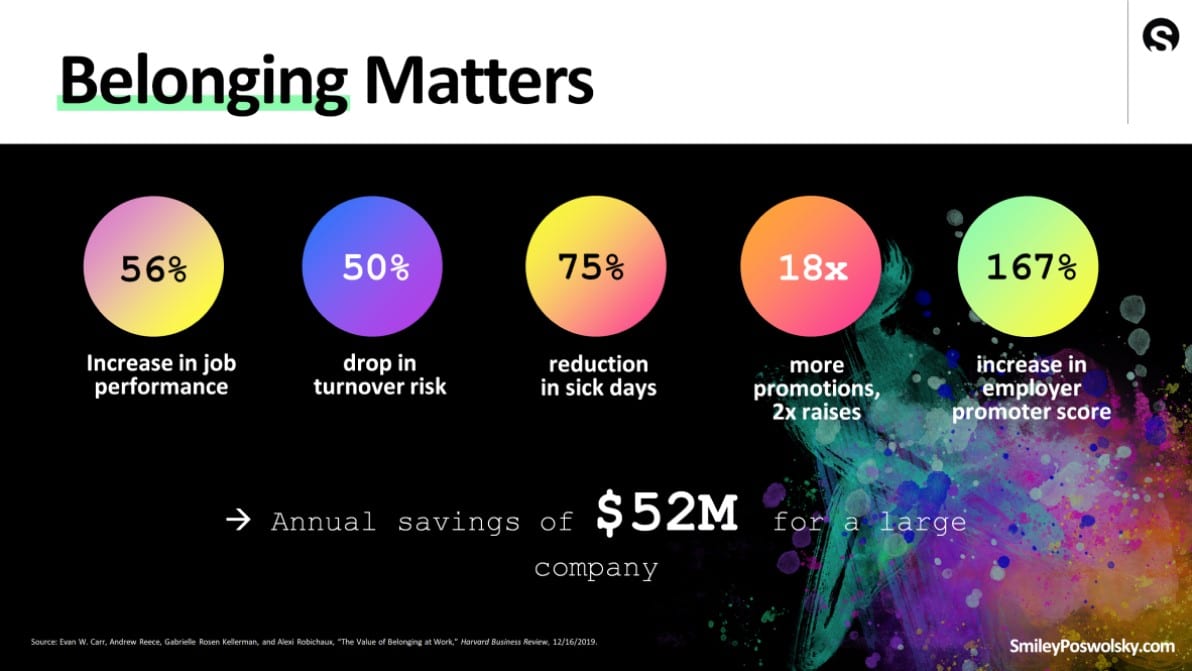Employee loneliness is a growing epidemic costing organizations billions annually in extensive absenteeism and elevated turnover, a recent Cigna report shows. The cure? Building a culture of belonging, Adam “Smiley” Poswolsky, a workplace belonging expert and best-selling author, told a crowd Wednesday during his opening keynote at the Elevate People, Ignite Change (EPIC) conference.
Whereas diversity is having a seat at the table and inclusion is having a voice, belonging is having a voice that is actually heard, Poswolsky says. A culture of belonging is one in which employees are seen for their unique contributions: connected with co-workers, supported in daily work and career development, and proud of the organization’s values and purpose.
Beyond strengthening a company’s financial footing, belonging can improve employee performance and wellbeing, Poswolsky said in his keynote speech, Belonging in the Future of Work: Creating Human Connection and Community in the Era of Hybrid, AI and Overwhelm.
Caring for others
Too often, employees lack a sense of belonging at work, which increases feelings of loneliness and can cost employers as much as $406 billion a year, says Poswolsky. This comes in the form of missed days at work, 45% lower productivity, lower quality of work and a higher risk of turnover.

“On the flip side, belonging is the anecdote. Belonging is the cure,” Poswolsky says.
By creating a culture of belonging, large employers can save $52 million annually. It begins, he says, when employees take this major step: “Stop comparing yourself to others, start caring for others.”
Caring for others—whether a cause, an individual or a community—helps people develop a sense of meaning and, therefore, connection and belonging, he notes.
HR leaders can help employees achieve this by creating a work environment where they can share their gifts of love, service and compassion with their colleagues, Poswolsky says. Employees can align their unique gifts to make an impact inside and outside of the organization.
Poswolsky offers six ways HR can help employees feel heard.
- Create a space where employees do not have to hide their true selves at work.
- Encourage employees to establish meaningful relationships at work.
- Use technology to help the workforce make meaningful connections.
- Foster ways for colleagues to have shared goals.
- Facilitate more in-person conversations.
- Ensure work/life separation by encouraging employees to leave work at work.

5 culture shifts for belonging in the workplace
He says leaders need to reimagine their culture, with belonging at the center, to make these actions sustainable. In particular, Poswolsky pointed to five major transformations that can create a culture that allows belonging to flourish.
Rethink purpose
While many organizations focus their purpose on lofty goals such as changing the world, they instead need to make their purpose listening to their people in order to drive belonging, Poswolsky said.
“Make meaning and belonging personal,” Poswolsky says.
For instance, employees, especially Gen Z employees, are increasingly asking for flexibility, which leaders need to be attuned to. This flexibility goes beyond the freedom of when and where to work to include autonomy, empowerment and agency in the type of projects to work on.
Make belonging everyone’s job
HR leaders need to nix the assumption that discussions about belonging are only reserved for their function. Instead, belonging should be understood and pursued by the entire workforce.
Making belonging a companywide topic can create psychological safety for team members. That, in turn, can result in a shared team belief that interpersonal risk-taking is safe.
Switch to culture transformation
Employers need to pivot from culture fit to culture transformation, Poswolsky says. This can be achieved by treating culture like a product instead of a value.
For example, rather than viewing culture through the lens of inclusion, open communication, co-creation, collaboration, growth and clarity, and transparency values, look at it via programs like diversity recruitment, onboarding cohorts and employee resource groups.
Shift human interactions to meaningful connections
On average, employees send and receive 125 business emails per day, check their inbox from 77 times up to 400 times a day, and check email or collaboration apps like Teams or Slack every six minutes. These rapid-fire employee interactions should be turned into more meaningful human exchanges, Poswolsky suggests.
He says this can be accomplished in several ways. Here are a few examples: Make onboarding and training a community-building exercise, deliver more face-to-face opportunities to connect and encourage employees to have non-work-related discussions.
Pivot to a care mindset
Finally, rather than focus on exponential growth, employers can turn to a caring mindset, which in turn bolsters a sense of employee belonging, Poswolsky says. For example, HR can encourage employees to conduct small acts of kindness.
The post How building belonging into company culture can save $52 million a year appeared first on HR Executive.